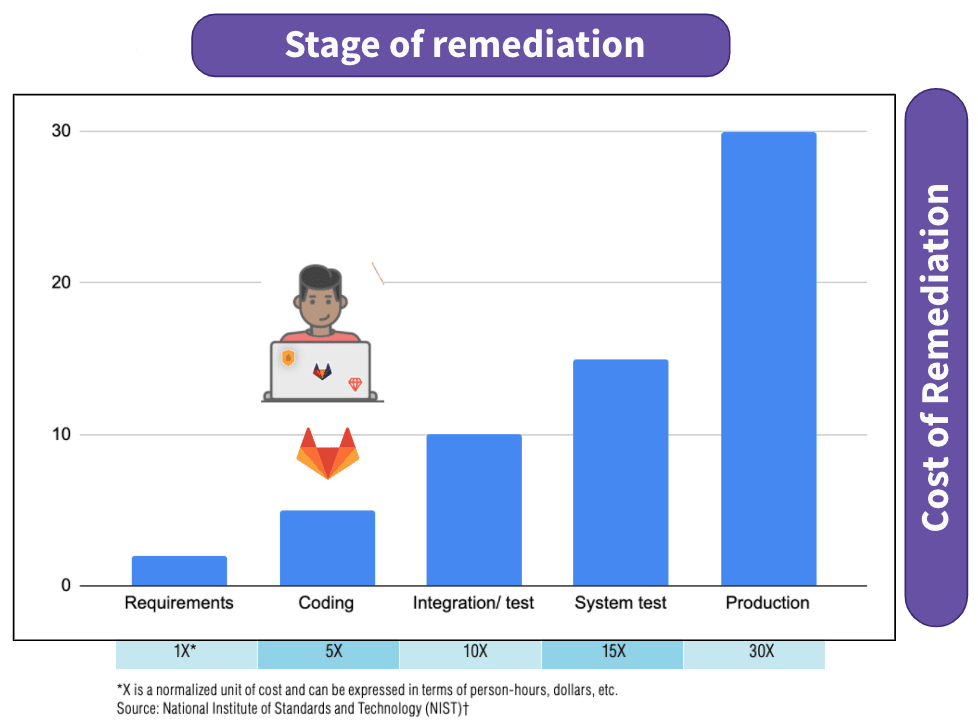What is DevSecOps?
DevSecOps is a software development approach that integrates security practices into every stage of the DevOps lifecycle to deliver secure software faster.
DevSecOps is a software development approach that integrates security practices into every stage of the DevOps lifecycle, ensuring that applications are built and delivered both quickly and securely.
Traditionally, security was treated as a final step in the development lifecycle, often leading to costly delays when vulnerabilities were discovered late in the process. DevSecOps solves this problem by embedding security into the workflow from the very beginning, often referred to as “shifting security left.”
Instead of security being a bottleneck, DevSecOps makes it a shared responsibility across development, operations, and security teams. By automating security checks, integrating them into CI/CD pipelines, and continuously monitoring applications in production, organizations can achieve the speed of DevOps while reducing risk.
Key principles of DevSecOps include:
-
Shifting left: Running security tests early in the development cycle.
-
Automation: Embedding security scans and policy checks into CI/CD pipelines.
-
Collaboration: Breaking down silos between developers, security teams, and operations.
-
Continuous monitoring: Detecting and responding to threats in live applications.
By adopting DevSecOps, teams can improve software quality, reduce vulnerabilities, and release secure applications faster without slowing down innovation.
DevSecOps extends DevOps by integrating security practices into every stage of the software development lifecycle, ensuring that security is a shared responsibility across development, operations, and security teams, not an afterthought applied at the end.
DevOps combines development and operations to increase the efficiency, speed, and security of software development and delivery compared to traditional processes. A more nimble software development lifecycle results in a competitive advantage for businesses and their customers.
Due to this, DevOps can be best explained as people working together to conceive, build, and deliver secure software at top speed. DevOps practices enable software developers (devs) and operations (ops) teams to accelerate delivery through automation, collaboration, fast feedback, and iterative improvement.
Although the term DevSecOps looks like DevOps with the Sec inserted in the middle, it’s more than the sum of its parts. DevSecOps is an evolution of DevOps that weaves application security practices into every stage of software development right through deployment with the use of tools and methods to protect and monitor live applications.
New attack surfaces such as containers and orchestrators must be monitored and protected alongside the application itself. DevSecOps tools automate security workflows to create an adaptable process for your development and security teams, improving collaboration and breaking down silos.
By embedding security into the software development lifecycle, you can consistently secure fast-moving and iterative processes, improving efficiency without sacrificing quality.

Application security is the use of software, hardware, and procedural methods to protect applications from external threats.
Modern approaches include shifting left, or finding and fixing vulnerabilities earlier in the development process, as well as shifting right to protect applications and their infrastructure-as-code in production. Securing the software development lifecycle itself is often a requirement as well.
This approach of building security into your development and operational processes effectively turns your DevOps methodology into a DevSecOps methodology. An end-to-end DevOps platform can best enable this approach.
DevSecOps is built on the principle of integrating security into every phase of the DevOps process, from planning and coding to deployment and monitoring, ensuring that development, operations, and security teams collaborate continuously to deliver secure, high-quality software faster.
If you’ve read the book that was the genesis for the DevOps movement, The Phoenix Project, you understand the importance of automation, consistency, metrics, and collaboration. For DevSecOps, you are essentially applying these techniques to outfit the software factory while embedding security capabilities along the way rather than in a separate, siloed process.
Both developers and security teams can find vulnerabilities, but developers are usually required to fix these flaws. It makes sense to empower them to find and fix vulnerabilities while they are still working on the code. Scanning alone isn’t enough.
It’s about getting the results to the right people, at the right time, with the right context for quick action. Fundamental DevSecOps requirements include automation and collaboration, along with policy guardrails and visibility.
Automation
GitLab’s 2022 DevSecOps Survey found that a majority of DevOps teams are running static application security testing (SAST), dynamic application security testing (DAST), or other security scans regularly, but fewer than a third of developers actually get those results in their workflow. A majority of security pros say their DevOps teams are shifting left, and 47% of teams report full test automation.
Collaboration
A single source of truth that reports vulnerabilities and remediation provides much-needed transparency to both development and security team. It can streamline cycles, improve developer experience, eliminate friction, and remove unnecessary translation across tools.
Policy guardrails
Every enterprise has a different appetite for risk. Your security policies will reflect what is right for you while the regulatory requirements to which you must adhere will also influence the policies you must apply. Hand-in-hand with automation, guardrails can ensure consistent application of your security and compliance policies.
Visibility
An end-to-end DevSecOps platform can give auditors a clear view into who changed what, where, when, and why from beginning to end of the software lifecyle. Leveraging a single source of truth can also ensure earlier visibility into application risks.
Adopting DevSecOps empowers organizations to build secure, reliable software faster by embedding security into every stage of the development lifecycle. Instead of treating security as a final checkpoint, DevSecOps integrates continuous security testing, automation, and collaboration between development, operations, and security teams.
This proactive approach not only reduces vulnerabilities and compliance risks but also accelerates delivery, improves developer productivity, and strengthens overall business resilience.
Proactively find and fix vulnerabilities
Unlike traditional approaches where security is often left to the end, DevSecOps shifts security to earlier in the software development lifecycle. By reviewing, scanning, and testing code for security issues throughout the development process, teams can identify security concerns proactively and address them immediately, before additional dependencies are introduced or code is released to customers.
Release more secure software, faster
If security vulnerabilities aren’t detected until the end of a project, the result can be major delays as development teams scramble to address the issues at the last minute. But with a DevSecOps approach, developers can remediate vulnerabilities while they’re coding, which teaches secure code writing and reduces back and forth during security reviews. Not only does this help organizations release software faster, it ensures that their software is more secure and cost efficient.
Keep pace with modern development methods
Customers and business stakeholders demand software that is fast, reliable, and secure. To keep up, development teams need to leverage the latest in collaborative and security technology, including automated security testing, continuous integration and continuous delivery (CI/CD), and vulnerability patching. DevSecOps is all about improving collaboration between development, security, and operations teams to improve organizational efficiency and free up teams to focus on work that drives value for the business.
Determining whether DevSecOps is the right fit depends on your organization’s current challenges and development maturity. DevSecOps is ideal for teams seeking to break down silos, accelerate delivery, and strengthen security without slowing innovation.
The benefits of DevSecOps are clear: speed, efficiency, and collaboration. But how do you know if it’s right for your team? If your organization is facing any of the following challenges, a DevSecOps approach might be a good move:
Development, security, and operations teams are siloed
If development and operations are isolated from security issues, they can’t build secure software. And if security teams aren’t part of the development process, they can’t identify risks proactively. DevSecOps brings teams together to improve workflows and share ideas. Organizations might even see improved employee morale and retention.
Long development cycles are making it difficult to meet customer or stakeholder demands
One reason for the struggle could be security. DevSecOps implements security at every step of the development lifecycle, meaning that solid security doesn’t require the whole process to come to a halt.
You’re migrating to the cloud (or considering it)
Moving to the cloud often means bringing on new development processes, tools, and systems. It’s a perfect time to make processes faster and more secure — and DevSecOps could make that a lot easier.
Building a true DevSecOps culture requires more than new tools, it demands a shift in mindset. Making the transition helps organizations detect and address security threats in real time, but success depends on collaboration, trust, and shared responsibility across development, security, and operations teams.
DevSecOps culture is about embedding security into everyday workflows so it becomes a natural part of the development process, not an afterthought. By fostering open communication, empowering every team member to take ownership of security, and creating continuous feedback loops, organizations can align people, processes, and technology toward the shared goal of delivering secure, high-quality software faster.
Here are five practical ways to prepare your team to fully embrace DevSecOps:
Remember that security and security professionals are valuable assets, not bottlenecks or barriers
Security should be viewed as an enabler of innovation, not an obstacle to it. When security teams are included early in the development process, they can proactively identify risks and implement protective measures before vulnerabilities become costly. By integrating security expertise from the start, organizations build resilience and reduce the friction that often occurs when teams work in silos.
Work in small, iterative cycles to detect vulnerabilities faster
Breaking down projects into small, manageable iterations allows teams to integrate, test, and release code continuously. This “shift-left” approach helps identify security issues earlier in the lifecycle, when they are cheaper and easier to fix. Frequent, smaller updates also minimize risk and make it easier to roll back or adjust when needed.
Encourage open collaboration and shared ownership of security
DevSecOps thrives in environments where every contributor feels empowered to participate in improving security and process quality. Encourage all team members, from developers to operations engineers, to comment, suggest improvements, and submit changes. This shared responsibility model drives innovation, transparency, and faster feedback cycles, making security a collective success metric rather than a separate function.
Build audit readiness into everyday workflows
Being “always audit-ready” ensures that compliance and security standards are maintained continuously rather than treated as a periodic requirement. Establish clear guidelines for documenting changes, collecting compliance information, and monitoring configurations. Automating audit trails and reporting through CI/CD pipelines helps teams stay compliant with minimal manual effort.
Train everyone on security best practices
The best DevSecOps programs invest in people as much as in technology. Regular hands-on training, workshops, and clear security guidelines help teams stay informed about emerging threats and industry best practices. By embedding continuous learning into your DevSecOps culture, you empower teams to make secure coding decisions instinctively, strengthening both code quality and confidence.
Ready to see how GitLab can help you get started with DevSecOps?
Our DevSecOps Solution page has all of the details, along with a Free Trial offer for our Ultimate tier of capabilities.
Manage your toolchain before it manages you
Visible, secure, and effective toolchains are difficult to come by due to the increasing number of tools teams use, and it’s placing strain on everyone involved. This study dives into the challenges, potential solutions, and key recommendations to manage this evolving complexity.
Frequently Asked Questions
Frequently Asked Questions
DevSecOps stands for development, security, and operations combined into a software development approach. The DevSecOps process integrates security throughout the development lifecycle rather than adding it at the end. This process embeds application security practices into every stage from development through deployment, using tools and methods to protect and monitor live applications.
DevSecOps is an evolution of DevOps that weaves application security practices into every development stage. While DevOps combines development and operations for speed and efficiency, DevSecOps adds security as a core component. It automates security workflows, monitors new attack surfaces like containers, and creates adaptable processes that improve collaboration between development and security teams.
The four fundamentals are automation for consistent security scanning and vulnerability detection, collaboration through single source of truth reporting to both development and security teams, policy guardrails that ensure consistent application of security and compliance policies, and visibility providing auditors clear views into changes throughout the software lifecycle.
DevSecOps enables teams to proactively find and fix vulnerabilities by shifting security earlier in the development lifecycle. Organizations can release more secure software faster since developers remediate vulnerabilities while coding rather than scrambling at project end. This approach keeps pace with modern development methods through automated testing, CI/CD, and improved collaboration.
Organizations should view security professionals as valuable assets rather than bottlenecks, work in small iterations to detect vulnerabilities quickly, allow everyone to contribute suggestions for code and process improvements, maintain audit readiness through compliance information collection, and train all team members on security best practices with detailed guidelines and hands-on training.
50%+ of the Fortune 100 trust GitLab
Start shipping better software faster
See what your team can do with the intelligent
DevSecOps platform.




